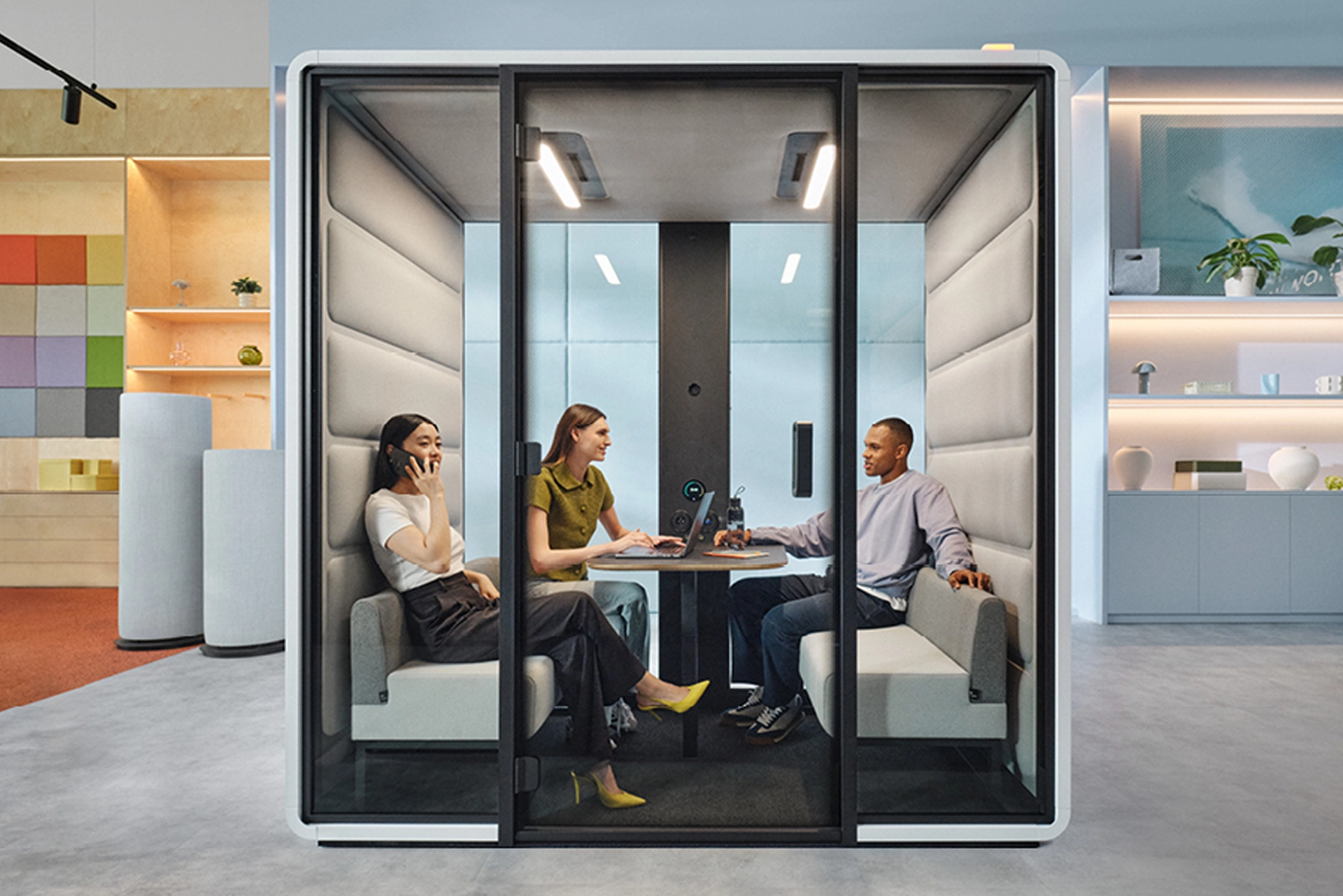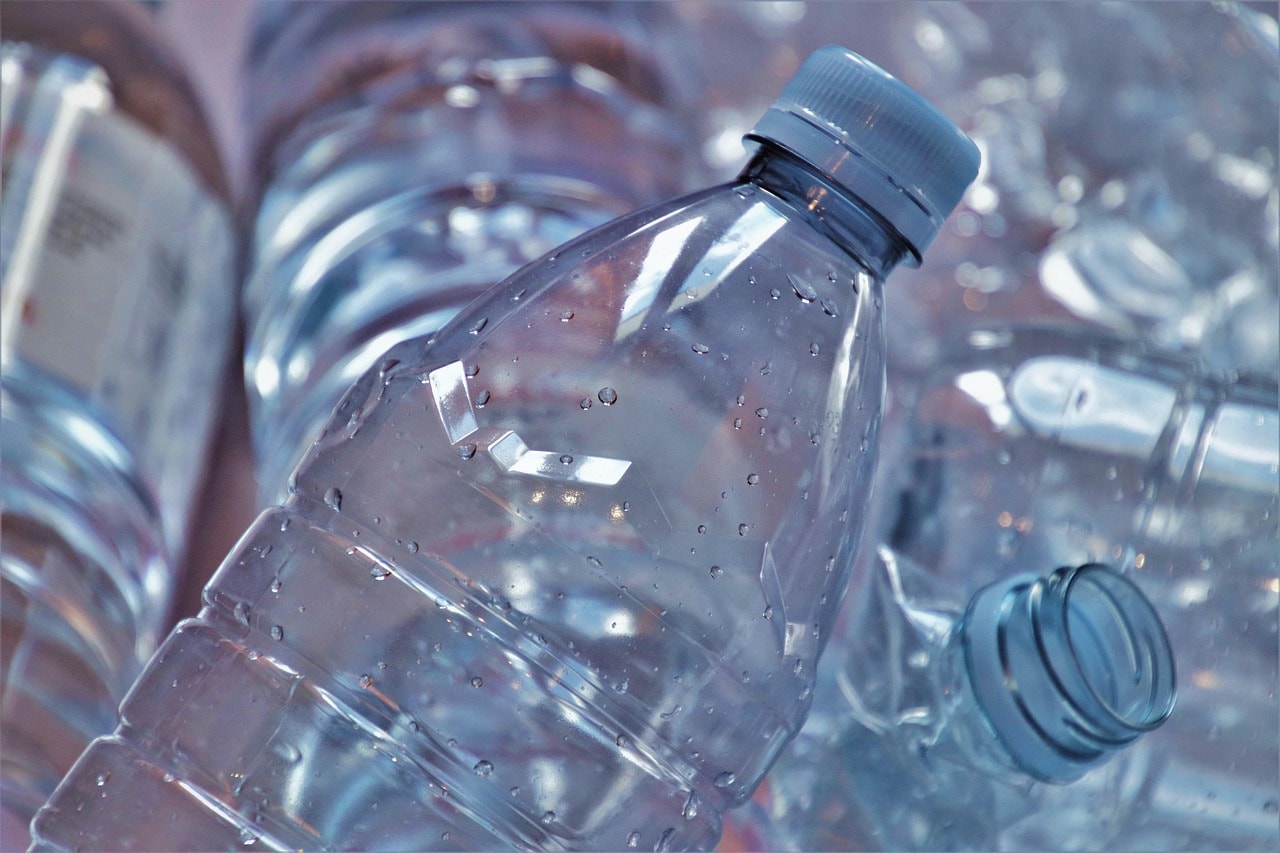Table of Contents
- Introduction – Why Using Quality Materials Matters?
- Common Office Pod Materials and Benefits
- Structural Framework: Metals and Wood Composites
- Acoustics and Sound-Absorbing Materials
- Sustainability in Office Pod Manufacturing
- Product Showcase
- Summary
- Get Started
Introduction – Why Using Quality Materials Matters?
Top-tier office pods balance strength, sustainability, and refined aesthetics. Office pods are long-term investments that should deliver resilience, safety, and timeless appeal. Superior materials ensure structural stability, reduce long-term maintenance, and align with sustainability goals. A well-built office pod doesn’t just endure daily use – it enhances user wellbeing and contributes to a lasting, professional environment.
Common Office Pod Materials & Benefits

Structural Framework: Metals & Wood Composites
Steel and Aluminum Framework
Steel serves as the primary structural framework in office pods, forming the skeleton that supports walls, ceilings, shelving, and desk mounts. Its high strength-to-weight ratio enables robust structures that are easily transported and assembled on-site, while galvanized or powder-coated finishes resist corrosion and provide a professional appearance. Steel is used in door frames, window frames, and mounting brackets for ventilation, electrical, and acoustic systems, with its high recyclability supporting sustainability goals.
Aluminum is extensively used for glazing systems, door frames, and window profiles due to its lightweight properties, corrosion resistance, and sleek aesthetics. Aluminum extrusions create the slim, modern lines of contemporary pods and can be anodized or powder-coated in various finishes.
In addition, excellent thermal properties suit double-glazed frames for sound insulation and temperature control, while its natural rust resistance makes it ideal for exterior pannelling and trim. Aluminum’s recyclability and lower weight compared to steel reduce transportation costs and environmental impact, making it a preferred choice for sustainable, portable workspace solutions.
- Use & Process: Often used for robust pod frames and structural components. Manufacturers may utilise recycled steel and aluminum, or even fossil-free (“green”) steel as it becomes available. Precision fabrication through CNC machining, laser cutting, welding, and bench joinery ensures tight tolerances and durability.
- Benefits: High structural integrity, long lifespan, lightweight (especially aluminum), and precision manufacturing.
- Sustainability: Both metals are highly recyclable with minimal quality loss, significantly reducing lifecycle emissions. Green steel and recycled aluminum cut CO₂ emissions – one manufacturer, Framery, aims for a 50% per‑pod CO₂ reduction by 2028.
Timber / Engineered Wood
Timber and engineered wood products are widely used in office pod manufacture for flooring, wall panels, and acoustic pannelling, providing warmth, natural aesthetics, and excellent sound absorption properties. Engineered wood like plywood, MDF, and OSB forms the core of wall and ceiling panels due to their dimensional stability, cost-effectiveness, and ease of cutting to precise specifications.
Timber framing is sometimes used as an alternative to steel for lighter-weight pods, while solid wood or wood veneers create attractive interior finishes that promote a calming, biophilic work environment. These materials also offer good thermal insulation and can be sustainably sourced, with many manufacturers opting for FSC-certified wood to meet environmental standards.
- Use & Process: Employed for finishes or internal structures. When sourced sustainably- e.g. FSC or PEFC-certified – it’s renewable and often modular.
- Benefits: Natural aesthetics, warmth, acoustic dampening, renewable if responsibly sourced.
- Sustainability: Acts as a carbon store during its lifespan; certified wood ensures ecosystem-friendly sourcing.
Acoustic & Sound-Absorbing Materials
Acoustic Foam & High-Density Foam Panels
Sound-absorbing materials in office pods include upholstered acoustic panels, fabric-wrapped panels, MLV, glasswool, foams, perforated wood panels, and laminates applied to walls and ceilings. Acoustic foam and high-density foam panels are installed within wall cavities, ceiling spaces, and door assemblies to control sound transmission and create quiet, distraction-free workspaces.
High-density foam dampens low-frequency sounds while lighter acoustic foam targets mid and high frequencies, together providing comprehensive sound insulation that meets workplace privacy requirements. The foam is typically laminated to interior panels or fitted behind decorative fabric surfaces, maintaining aesthetic appeal while achieving noise reduction ratings of 30-40 decibels – suitable for private calls, focused work, and confidential meetings in open-plan environments.
- Use & Process: Installed within walls and ceilings to dampen sound. They absorb sound waves, reducing echo and transmission.
- Benefits: Efficient at reducing ambient noise, improving privacy and concentration.
- Sustainability: Varies by material; some are eco-designed, others less so
Fabric-Wrapped or PET Acoustic Panels
PET acoustic felt is manufactured from recycled plastic bottles (polyethylene terephthalate fibers) processed into dense, fibrous panels or sheets. This eco-friendly material has become increasingly popular in office pods due to its excellent sound absorption properties, lightweight nature, and sustainable credentials. The felt’s porous structure effectively traps sound waves across a broad frequency range, reducing echo and reverberation while improving speech intelligibility.
Its non-toxic, formaldehyde-free composition contributes to healthier indoor air quality in confined workspaces. PET felt is applied as wall panels, ceiling tiles, decorative baffles, and door inserts in thicknesses of 9-12mm and various colors, allowing custom acoustic solutions including laser-cut patterns and branded designs. The material offers thermal insulation, natural fire resistance (Class B and Class 1 ratings), minimal maintenance, and contains 60-100% recycled content with full end-of-life recyclability, aligning with corporate sustainability goals while delivering superior acoustic comfort.
High Performance Fabrics
Agua Fabrics is a UK-based, fourth-generation family business specialising in high-performance contract upholstery fabrics and faux leathers for workplace environments, particularly acoustic office pods and seating booths. Their products meet top-tier safety standards (Crib 5, BS 7176, IMO), feature fire-retardant, waterproof, stain-resistant properties, and include AguaGuard 365 antimicrobial treatment effective against bacteria, viruses (including Covid-19), MRSA, and E. coli.
With exceptional abrasion resistance, easy maintenance, and diverse collections like Task, Buro, Lavoro, and Tones offering various textures and colors, Agua fabrics provide design flexibility while reducing long-term refurbishment costs. The company offers UK stock with rapid dispatch, free samples, and dedicated project support. Their VerdEco collection provides a sustainable option made from 100% recycled yarns with zero water production (saving ~250 liters per three-seater sofa), available in 35 shades while maintaining fire safety standards without waterproof or antimicrobial treatments to preserve eco-credentials.
Using Wool For Noise Absorption
Blazer is a 100% virgin wool felted upholstery fabric spun, woven, dyed, and milled in the UK, available in ~77 colors with EU Ecolabel certification, independently verified EPD, and Indoor Advantage™ Gold for low VOCs. Blazer Lite is the lighter, wide-width (170 cm) version designed for vertical panels, acoustic applications, and drapery, ideal for pod walls and baffles with fewer seams while maintaining the same environmental certifications.
Both fabrics are acoustically transparent, allowing sound to pass through to absorbers (foam/mineral cores) rather than reflecting off the surface, making them perfect face fabrics for office pods, acoustic screens, and sound-controlled environments where effective noise absorption is essential.
- Use & Process: Core panels (often PET, polyester, or recycled PET) are wrapped with acoustically tuned fabric such as Agua, Blazer etc. Inside, they may use 100% recycled PET.
- Benefits: Effective noise absorption, varied aesthetic finishes (wood-look, fabric, moss, etc.), flexible design.
- Sustainability: Recycled PET and acoustic fabrics reduces waste and supports circular economy.
Measuring Fabric Durability
The Martindale scale is a standardizsed test measuring fabric durability and abrasion resistance by rubbing samples in a controlled circular motion against an abrasive surface and recording the number of cycles (rubs) before visible wear appears. Ratings range from 10,000–15,000 rubs (light domestic use) to 40,000+ rubs (heavy commercial use like hotels and airports), with high-performance fabrics exceeding 100,000 rubs for extremely demanding environments.
This benchmark helps manufacturers ensure quality standards, buyers select appropriate fabrics for their intended use (e.g., home sofas vs. office furniture), and designers compare performance when specifying materials for different applications.
Mass-Loaded Vinyl (MLV)
Mass-Loaded Vinyl (MLV) is incorporated into office pod walls, floors, and ceilings as a dense, flexible sound barrier that blocks noise transmission between the pod and surrounding spaces. This heavy, limp membrane is typically sandwiched between structural panels and acoustic foam layers, significantly enhancing the pod’s overall soundproofing performance without adding excessive bulk or weight to the structure.
- Use & Process: A dense, flexible material incorporated into walls to form a sound barrier layer – blocks sound transmission effectively.
- Benefits: Great at isolating sound – especially low-frequency noise.
- Sustainability: Not inherently eco-friendly, though critical for acoustic performance in high-security designs.
Multi-Layered Insulated Glass
Tempered Glass Standard for walls and doors to maintain visual connection while providing sound barriers.
- Use & Process: Double or triple-glazed panels incorporated into pod walls or doors for acoustic privacy.
- Benefits: Reduces noise transmission while allowing light and visual connection.
- Sustainability: Durable glass is fully recyclable though production consumes energy.
Perforated Wood Panels
Perforated wood panels are used in office pods as decorative interior pannelling that combines aesthetic appeal with acoustic functionality, with their precisely drilled hole patterns allowing sound waves to pass through and be absorbed by foam backing materials. These panels create a warm, natural finish while reducing echo and reverberation inside the pod, enhancing speech clarity and overall acoustic comfort for occupants.
- Use & Process: Used inside pods to absorb mid‑to‑high frequencies; also decorative.
- Benefits: Enhances acoustics, adds warmth and aesthetics.
- Sustainability: If sustainably sourced, it’s renewable and recyclable.
Laminate & Acrylic Panels
Laminate and acrylic panels are used in office pod manufacture as durable, easy-to-clean interior and exterior surfaces that offer a wide range of colors, textures, and finishes to match corporate branding or design preferences. These panels are applied over core structural materials to provide scratch-resistant, moisture-resistant pannelling for walls and work surfaces, while acrylic panels are also used for decorative lighting diffusers and modern translucent accent features.
EGGER is a European manufacturer of wood-based laminates consisting of melamine resin-impregnated paper bonded to particleboard or MDF, widely used in office pods for panels, desks, walls, doors, and storage. These surfaces offer scratch and impact resistance, extensive design options, easy maintenance, and cost-effectiveness compared to solid wood, while fire-retardant variants ensure safety compliance in enclosed spaces. EGGER emphasizes sustainability through FSC® and PEFC™ certified materials, recycled wood content, closed-loop production, and low formaldehyde emissions (E1, CARB2 standards), making their laminates a durable, attractive, and environmentally responsible choice for modular office pod construction.
FENIX NTM is an advanced nano-material by Italian manufacturer Arpa Industriale, consisting of resin-impregnated paper layers with acrylic resin surfaces cured via electron beam technology to create a dense, non-porous finish. It features an ultra-matte, anti-fingerprint surface with self-healing properties for minor scratches, high durability against heat and chemicals, low reflectivity ideal for screen-heavy workspaces, and exceptional hygiene due to its easy-to-clean surface.
Available as solid FENIX (full-thickness) or bonded FENIX (thin layer on substrate), it’s widely used in office pods for worktops, desktops, and cabinetry. FENIX is carbon neutral since 2021, incorporates up to 67% bio-based content through Bloom technology, and reduces CO₂ emissions by ~31%, making it a premium, sustainable choice for modern, design-forward office interiors.
- Use & Process: Used for surfaces – laminate can double as whiteboards; acrylic surfaces may be used for light transmission or design features.
- Benefits: Functional versatility (note takers, branding), customisable finishes.
- Sustainability: Mixed-acrylic is plastic-based; laminates vary in recyclability.
Sustainability in Office Pod Manufacturing
Office pods incorporate a range of materials chosen for their performance, durability, and environmental credentials. From structural frameworks to acoustic solutions and surface finishes, manufacturers increasingly prioritize recyclability, reduced emissions, and circular economy principles to minimize environmental impact while maintaining functionality and design quality.
Key Materials & Sustainability Benefits:
- Steel & Aluminum Frameworks – Highly recyclable with minimal quality loss; green steel and recycled aluminum significantly reduce CO₂ emissions across the lifecycle, with some manufacturers targeting 50% per-pod emission reductions.
- Timber & Engineered Wood – Acts as a carbon store during its lifespan; FSC/PEFC certified wood ensures responsible, renewable sourcing that protects ecosystems.
- PET Acoustic Felt – Made from 60-100% recycled plastic bottles; fully recyclable at end-of-life, diverting waste from landfills while supporting circular economy principles.
- High-Performance Fabrics (Agua, Blazer) – VerdEco collection uses 100% recycled yarns with zero water production (saving ~250L per sofa); Blazer carries EU Ecolabel and low VOC certifications for healthier indoor environments.
- EGGER Laminates – FSC/PEFC certified with recycled wood content, closed-loop production, and low formaldehyde emissions (E1, CARB2 standards) for responsible manufacturing.
- FENIX NTM – Carbon neutral since 2021; up to 67% bio-based content reduces CO₂ emissions by ~31%, energy use by ~25%, and water consumption by ~36%.
- Multi-Layered Glass – Fully recyclable and durable, extending product lifespan and reducing replacement frequency.
- Perforated Wood Panels – Renewable and recyclable when sustainably sourced; adds natural warmth while supporting responsible forestry.
- Advanced Bio-Composites – Mycelium panels are biodegradable, compostable, and carbon-negative, grown from agricultural waste; recycled composites like UBQ and Polygood divert landfill waste while featuring low VOCs and reduced carbon footprints versus conventional materials.
Product Showcase
| Product | Materials & Components | Benefits | Link |
|---|---|---|---|
| HushFree XS Phone Booth |
|
Creates a quiet, private, and comfortable workspace that enhances concentration and minimizes distractions. | View Product |
| Framery Four Meeting Pod |
|
Delivers a robust, acoustically optimised environment for meetings and collaboration, blending longevity, sustainability, and style. | View Product |
| My Work Pod |
|
Creates a solid, stylish, and acoustically balanced environment ideal for focused solo work in modern offices. | View Product |
Summary
Office pods are long-term investments requiring superior materials that balance strength, sustainability, and aesthetics. Quality materials ensure structural stability, reduce maintenance, enhance wellbeing, and align with environmental goals.
Structural Framework
Steel and aluminum form the structural backbone through powder-coated frames, door/window systems, and mounting brackets, offering high strength-to-weight ratios ideal for transport and assembly. Both metals are highly recyclable with minimal quality loss, supporting significant CO₂ reductions. Timber and engineered wood products like plywood, MDF, and OSB serve as wall panels, flooring, and pannelling, with FSC-certified options acting as carbon stores while providing natural aesthetics and thermal insulation.
Acoustic & Sound-Absorbing Materials
Acoustic foam and high-density panels absorb sound waves across frequency ranges, achieving 30-40 decibel noise reduction within wall cavities and door assemblies. PET acoustic felt, made from 60-100% recycled bottles, offers fire resistance and full recyclability while being formaldehyde-free. High-performance fabrics like Agua and Blazer wool provide acoustically transparent face coverings that allow sound to pass through to absorbing cores, with antimicrobial treatments and EU Ecolabel certifications. Mass-Loaded Vinyl acts as a dense barrier blocking noise transmission, while perforated wood panels and multi-layered insulated glass combine aesthetics with acoustic functionality, maintaining visual connection and natural light.
Surface Finishes & Laminates
EGGER laminates provide scratch-resistant, cost-effective surfaces with FSC/PEFC certification, recycled content, and low formaldehyde emissions for panels, desks, and storage. FENIX NTM offers premium nano-material surfaces featuring ultra-matte, anti-fingerprint, self-healing properties, achieving carbon neutrality with up to 67% bio-based content and 31% CO₂ emission reductions. Acrylic panels serve decorative and functional roles for lighting diffusers and design features.
To Conclude
Modern manufacturing prioritises recyclability, reduced emissions, and circular economy principles – from recyclable metals and certified wood to recycled PET, zero-water fabrics, carbon-neutral laminates, and biodegradable bio-composites.
🔧Get Started
Understanding what goes into an office pod is just the beginning. If you’re looking to invest in a solution that balances 🔇 acoustic performance, 🌱 sustainability, and 🧩 lasting design, our expert team can guide you through the best material and specification options for your space.
-
📩 Contact us today to discuss your project requirements with an office pod specialist.
-
📞 Call us directly on 020 3301 3186 for personalised advice on selecting pods that align with your performance, sustainability, and aesthetic goals.
Let’s build your workspace around quality – one pod at a time. 🏢✨





